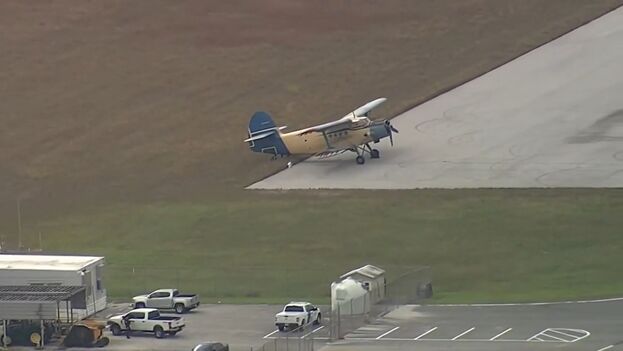
![]() 14ymedio, Havana, 21 October 2022 — Cuban pilot Rubén Martínez left the Island this Friday in a Russian-made Antonov AN-2 aircraft with registration 1885, which landed at Dade-Collier Training and Transition Airport, Florida, around 11:30 am.
14ymedio, Havana, 21 October 2022 — Cuban pilot Rubén Martínez left the Island this Friday in a Russian-made Antonov AN-2 aircraft with registration 1885, which landed at Dade-Collier Training and Transition Airport, Florida, around 11:30 am.
According to local U.S. media reports, the authorities confirmed that the pilot had flown from Sancti Spíritus and that he “took a selfie next to the plane after landing,” reports NBC Miami.
In the Dade-Collier airport, located on Tamiami Trail, in the middle of the Florida Everglades and west of Miami, Martínez was interrogated by Customs and Border Protection agents.
The air terminal where the Cuban landed was built for supersonic planes and sometimes is used for pilots to practice takeoffs and landings, said WSVN News, which added that Martinez remains in the custody of Customs and Border Protection.
The AN-2 model, a single-engine biplane designed by the Russian company Antonov, had its first flight on August 31, 1947. Due to its versatility, it has been used as a tanker aircraft during forest fires. It has a capacity to transport 12 passengers and has also been used as an air ambulance. It is usually used in fumigation work.
A fleet of this type of aircraft was assembled in Cuba in 2017 for fumigation, offering services to the tourism sector, cargo transportation and firefighting, as published then by the official press.
Rubén Martínez was a pilot of the Cuban Air Services Company (ENSA) that belongs to the Cuban Aviation Corporation administered by the Cuban Government. ENSA provides services mainly with fumigation aircraft.
In 2003, an Antonov 24 aircraft from Cubana de Aviación was diverted from the Island to Key West (Florida). The Cuban Adermis Wilson Gonzále, armed with a hand grenade, wanted the plane to land in Miami, but due to lack of fuel the pilot had to make an emergency landing at the José Martí airport in Havana, where he stayed 14 hours.
After intense negotiations, 22 passengers were released, and the plane departed with 25 other people and six crew members to Key West, where it arrived on April 1, 2003, escorted by American warplanes.
A year ago, González, who worked as a civilian construction technician on Isla de la Juventud, was released after serving almost 20 years in a U.S. prison, after being sentenced by a Florida court for air piracy.
Rubén Martínez’s escape this Friday dusted off the case of spy René González Sehwerert, who in 1990, when Cuba began to feel the economic havoc after the fall of the Soviet Union, took one of the small planes from the airfield where he worked as a flight instructor to leave the Island and arrive after an hour’s trip to the United States.
Between October 2021 and August 2022, more than 200,000 Cubans were intercepted by U.S. authorities, according to data from the United States Customs and Border Protection Office. So far, in the first month of fiscal year 2022, more than 400 were intercepted at sea aboard rudimentary vessels.
Translated by Regina Anavy
____________
COLLABORATE WITH OUR WORK: The 14ymedio team is committed to practicing serious journalism that reflects Cuba’s reality in all its depth. Thank you for joining us on this long journey. We invite you to continue supporting us by becoming a member of 14ymedio now. Together we can continue transforming journalism in Cuba.
